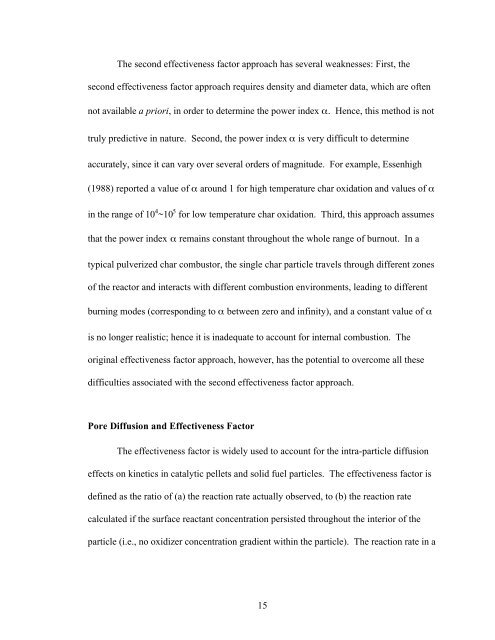MODELING CHAR OXIDATION AS A FUNCTION OF PRESSURE ...
MODELING CHAR OXIDATION AS A FUNCTION OF PRESSURE ...
MODELING CHAR OXIDATION AS A FUNCTION OF PRESSURE ...
Create successful ePaper yourself
Turn your PDF publications into a flip-book with our unique Google optimized e-Paper software.
The second effectiveness factor approach has several weaknesses: First, the<br />
second effectiveness factor approach requires density and diameter data, which are often<br />
not available a priori, in order to determine the power index . Hence, this method is not<br />
truly predictive in nature. Second, the power index is very difficult to determine<br />
accurately, since it can vary over several orders of magnitude. For example, Essenhigh<br />
(1988) reported a value of around 1 for high temperature char oxidation and values of<br />
in the range of 10 4 ~10 5 for low temperature char oxidation. Third, this approach assumes<br />
that the power index remains constant throughout the whole range of burnout. In a<br />
typical pulverized char combustor, the single char particle travels through different zones<br />
of the reactor and interacts with different combustion environments, leading to different<br />
burning modes (corresponding to between zero and infinity), and a constant value of<br />
is no longer realistic; hence it is inadequate to account for internal combustion. The<br />
original effectiveness factor approach, however, has the potential to overcome all these<br />
difficulties associated with the second effectiveness factor approach.<br />
Pore Diffusion and Effectiveness Factor<br />
The effectiveness factor is widely used to account for the intra-particle diffusion<br />
effects on kinetics in catalytic pellets and solid fuel particles. The effectiveness factor is<br />
defined as the ratio of (a) the reaction rate actually observed, to (b) the reaction rate<br />
calculated if the surface reactant concentration persisted throughout the interior of the<br />
particle (i.e., no oxidizer concentration gradient within the particle). The reaction rate in a<br />
15
















